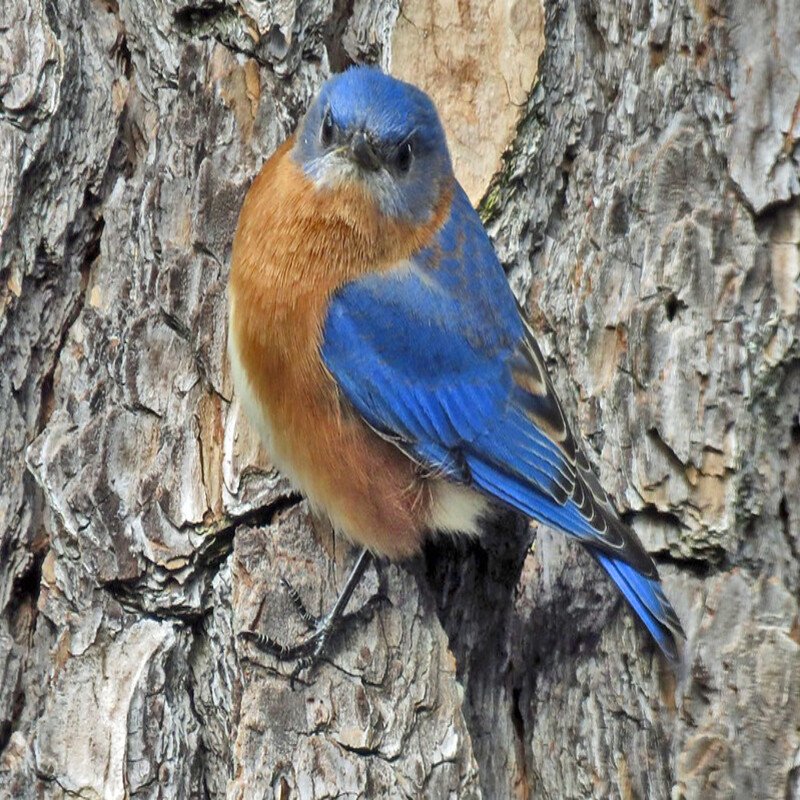In North America, the eastern bluebird, Sialia siali breeds in open forests, farmlands, and orchards. They belong to the Turdidae family. The male’s striking blue breeding plumage on a wire or exposed perch attracts birders. The male’s cry is a quiet jeew or chir-wi warble or the beautiful tune chiti WEEW wewidoo.
Quick Overview: Sialia Sialis – Eastern Bluebird
Body size: Around 7-7.75 in (18-20 cm) and a weight of 31 g (1.1 oz)
Main colors: Blue, Red, Brown, White, Gray
Range: Eastern United States
Migratory Bird: Yes
Best time of the year to see in the U.S.: All Year (January – December)
Conservation Status: Least Concern
Eastern Bluebird Description
Eastern bluebirds have thin beaks and short legs. They have a blue upper body, red/brown breast, and a white abdomen. Males have blue wing and tail feathers with gray shafts and tips. Their heads are a lighter blue, with a crimson neck and breasts. The breast and belly are white with pale blue feather tips. Females have a similar pattern, but are duller and have more gray than males.

Size
These birds have a length of 7-7.75 in (18-20 cm) and a weight of 31 g (1.1 oz). Their wings could range from 11.5-13 in (29-33 cm).
Feeding
Seasonally, eastern bluebirds eat a range of foods. During the summer, eastern bluebirds eat largely beetles, crickets, caterpillars, grasshoppers, and other insects. A US Biological Survey survey of 855 eastern bluebirds indicated that they eat insects 68% of the time. Foraging for insects, eastern bluebirds consume fruits and plants including wild grapes, blackberries, honeysuckle, and dogwood throughout the fall and winter.
Habitat
Perching, nesting, and feeding are preferred in open areas with dispersed trees. They frequent parks, gardens, hedges, and other perches. They frequently perch on fences and utility lines.
Behavior
They can congregate in flocks of 100 or more. But they are territorial. During the mating season, they defend a nesting and feeding region, and a winter feeding territory. Eastern bluebirds migrate. They leave their northern habitats when food becomes limited or when the weather becomes unsuitable. Bluebirds frequently fly from a perch to the ground to gather insects or other prey. This bird’s top speed is 17 mph.
Sialia Sialis Scientific Classification
- Kingdom: Animalia
- Phylum: Chordata
- Subphylum: Chelicerata
- Class: Aves
- Order: Passerifomes
- Family: Turdidae
- Genus: Sialia
- Species: Sialia sialis
Best time of the year to see
In the United States, the best time of year to see these birds is all year round, regardless of the season. This refers to any month of the year between January and December.
Distribution of the Eastern Bluebird in the USA
Breeds east of the Rockies, from southeastern Canada to the Gulf of Mexico; spends the winter in the breeding range’s southernmost section and into Mexico.
The Eastern Bluebird can be found in the following states in the United States – Alabama, Alaska, Arizona, Arkansas, Colorado, Connecticut, Delaware, Florida, Georgia, Hawaii, Illinois, Indiana, Iowa, Kansas, Kentucky, Louisiana, Maine, Maryland, Massachusetts, Michigan, Minnesota, Mississippi, Missouri, Montana, Nebraska, New Hampshire, New Jersey, New Mexico, New York, North Carolina, North Dakota, Ohio, Oklahoma, Pennsylvania, Rhode Island, South Carolina, South Dakota, Tennessee, Texas, Vermont, Virginia, West Virginia, Wisconsin, and Wyoming.

